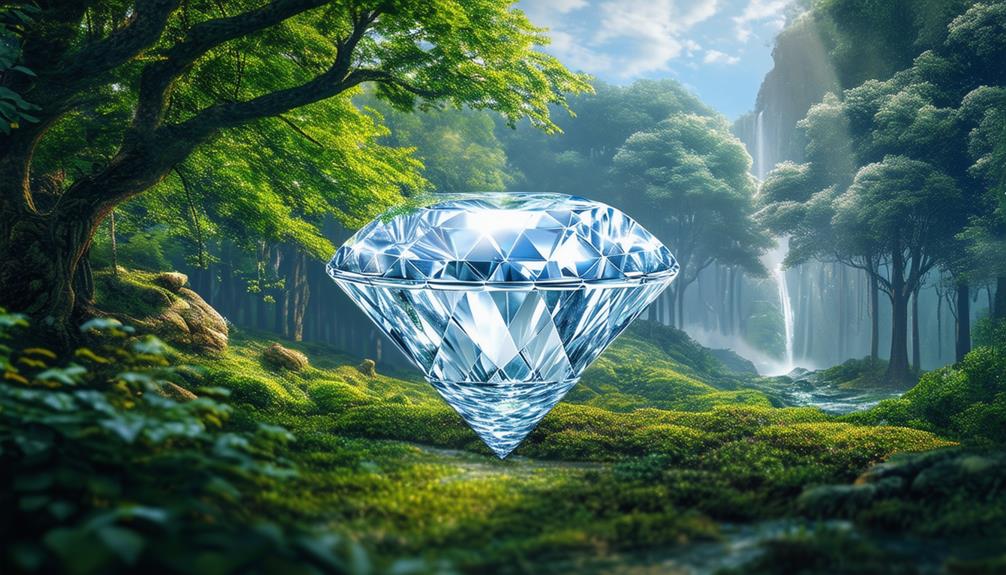Article Contents
Lab-created diamonds significantly reduce the environmental impact associated with traditional diamond mining. These diamonds are produced in controlled environments, which reduces land and water degradation, thereby preserving ecological balance.
Furthermore, the manufacturing process of synthetic diamonds emits notably fewer carbon emissions compared to conventional methods, promoting a cleaner and more sustainable production approach. Additionally, the use of renewable energy sources like solar and wind in creating these diamonds enhances their sustainability profile.
These factors collectively highlight the environmental advantages of lab-created diamonds.
Key Points
- Lab-grown diamonds minimise environmental degradation by reducing the impact on land and water, thus helping to preserve natural ecosystems.
- The production of diamonds in laboratories emits significantly lower levels of carbon compared to traditional mining methods.
- By using renewable energy sources such as solar and wind, lab-created diamonds contribute to increased sustainability.
- The controlled environments of diamond labs promote energy efficiency and cleaner production techniques.
- This method of diamond production supports global efforts to address climate change and encourages environmentally responsible consumption.
Reduced Impact on Land and Water
Lab-grown diamonds significantly reduce the environmental impact associated with traditional diamond mining by minimising land degradation and water depletion. These diamonds are produced in controlled laboratory settings, which avoids the extensive land excavation that leads to deforestation and habitat destruction. This method preserves natural landscapes and the wildlife that inhabits these areas, supporting ecosystem conservation.
Additionally, the production of lab-grown diamonds utilises far less water compared to traditional mining, which is typically water-intensive and can deplete local water sources and harm aquatic ecosystems. The advanced technology used in diamond synthesis in labs ensures efficient water use, contributing to the conservation of water resources and helping maintain ecological balance.
Reduce Carbon Emissions
Lab-created diamonds significantly reduce carbon emissions compared to traditional diamond mining, offering a sustainable alternative that meets the increasing demand for environmentally responsible luxury goods. By employing advanced technologies in controlled environments, these diamonds achieve greater energy efficiency, thereby minimising their carbon footprint. In contrast, traditional mining disrupts ecosystems and releases substantial amounts of carbon dioxide. Lab-grown diamonds, therefore, provide a cleaner production process with reduced emissions and environmental impact.
The environmental advantages of lab-created diamonds are significant. These stones meet the same aesthetic and durability standards as mined diamonds but with a much lower environmental impact. This method helps preserve natural landscapes and promotes more sustainable consumption practices within the jewellery industry. Choosing lab-created diamonds allows consumers to directly contribute to reducing greenhouse gas emissions and supports global efforts to combat climate change. Thus, lab-grown diamonds exemplify how innovative technology can align with environmental conservation, leading to a more sustainable luxury industry.
Integration of Renewable Energy
The adoption of renewable energy sources such as solar and wind power is significantly enhancing the sustainability of lab-created diamond production. This shift not only improves energy efficiency but also promotes sustainable practices within the industry, thereby reducing the reliance on environmentally damaging processes.
Utilising solar and wind energy in diamond manufacturing reduces the ecological impact and aligns with global initiatives to mitigate climate change. This strategy decreases the dependence on fossil fuels and supports a cleaner, more sustainable production method, appealing to environmentally conscious consumers.
Here is a summarised table reflecting the advantages of renewable energy integration in lab-created diamond production:
| Aspect | Benefit | Impact on Industry |
|---|---|---|
| Solar Power | Reduces energy costs | Enhances market competitiveness |
| Wind Power | Lowers greenhouse gas emissions | Promotes environmental stewardship |
| Energy Efficiency | Optimises resource use | Strengthens sustainability commitments |
Frequently Asked Questions
Do lab-grown diamonds impact the environment?
Lab-grown diamonds decrease their environmental impact by using less energy and generating less waste compared to conventional diamond mining. This approach provides a sustainable choice for consumers who want luxury goods with a smaller ecological footprint.
Are lab-created stones better for the environment?
Lab-created stones are considered more environmentally friendly than their mined counterparts due to their production processes, which typically require less energy and result in a smaller carbon footprint. This sustainable approach helps mitigate the extensive ecological impact associated with traditional mining practices.
What Are the Drawbacks of Lab-Grown Diamonds?
The primary drawbacks of lab-grown diamonds are their high energy needs and significant carbon emissions, which go against their image as an environmentally friendly option. Additionally, fluctuating production expenses could impact their pricing and availability.
What Do Experts Say About Lab-Grown Diamonds?
Experts acknowledge lab-grown diamonds for their alignment with current market trends and positive consumer perceptions. They emphasise the substantial decrease in environmental impact that these diamonds signify, as well as their suitability with renewable energy sources. This makes them an attractive option for environmentally aware consumers.
Summary
Lab-created diamonds significantly reduce the environmental impact associated with traditional diamond mining. These diamonds are produced in controlled environments using advanced technologies that minimise land degradation, water use, and carbon emissions.
By leveraging renewable energy sources, the production of lab-grown diamonds presents a more sustainable alternative, reflecting the jewellery industry's commitment to ecological responsibility and innovation.
This approach supports a sustainable future, aligning with global environmental conservation goals.

